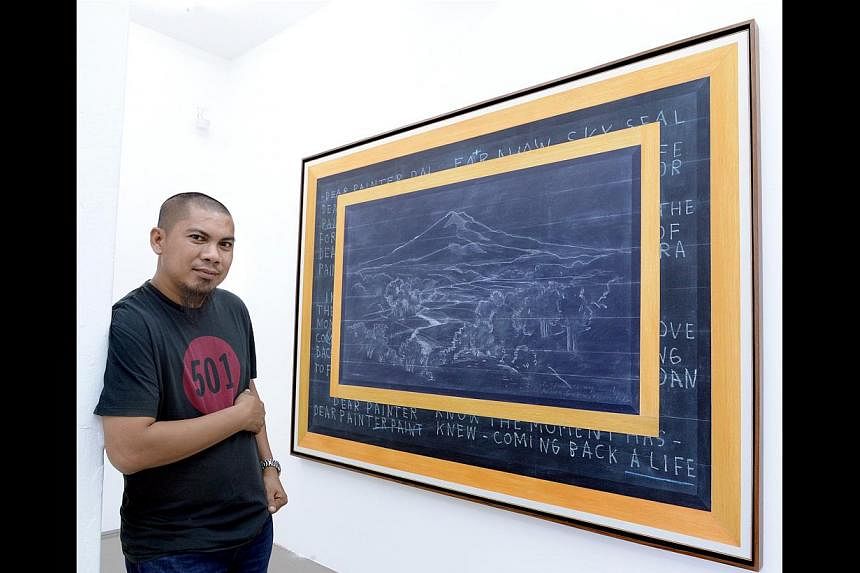Indonesian artist Jumaldi Alfi says he is bringing his popular series of blackboard paintings to an end.
He says it is time to move on from the series which he started five years ago and describes as almost an obsession.
"At some point every artist wants to move out of his comfort zone, to try something new. I have been feeling like that for some time now."
Using the format of a painting within a painting, he juxtaposes the blackboard concept with the Mooi Indies (which means beautiful Indies in Dutch) style of painting popularised in Indonesia during the Dutch colonial period.
This was a style of idealised, idyllic landscape painting that offered a glossed up view of Indonesia.
Alfi's last instalment is on show at ARNDT Singapore in Gillman Barracks until July 5. Melting Memories: Rereading Landscape - Mooi Indies features six recent paintings priced between US$30,000 (S$37,586) to US$35,000.
Alfi says he was drawn to this narrative, which has caught the attention of collectors globally, as a way of getting a better understanding of himself as an artist and the many influences that have shaped him and his country's art.
Says the chatty 40-year-old: "For me, using the Mooi Indies style was not just about the landscape or about creating pretty paintings, it has also been a way of getting a better sense of my country's history and how colonisation impacted us."
From a distance, his paintings look like idyllic settings rendered in the original style, but a close look proves otherwise. Through words cleverly hidden in canvases or statements made on what looks like a painting frame, he asks questions about the country and the state it is in, while examining the historical roots of modern and contemporary Indonesian art.
"Sometimes the idea of nostalgia or looking at the past can help us make sense of the present," he says.
His compelling visual iconography and the kind of detail that goes into his canvases have contributed to his art travelling around the world.
In 2010, the paintings done in the Mooi Indies style were shown for the first time outside of Indonesia at the now defunct Valentine Willie Fine Art here. They have since travelled to art fairs and been part of group shows around the world and were featured as a solo show at Primo Marella Gallery in Milan last year. The gallery actively promotes South-east Asian artists.
Alfi says the response to the paintings has surprised him and he did not expect collectors to remain interested in them for so long.
His energetic, fast-talking manner and sense of humour belie the stereotype of the isolated artist.
"If no one comes to my studio all day, I start thinking what I did wrong."
He thrives on company and often travels with his fellow Indonesian artists, playing the role of translator.
He is a founding member of Indonesia's Jendela Art Group, which has impressed international audiences with its refreshing and cutting-edge artworks.
To promote a younger generation of artists, he co-founded and runs the Office: For Contemporary Art International in Yogyakarta, which organises exhibitions, lectures and offers art residencies for emerging artists.
Art, to him, is all about sharing. He thinks it has to do with his own life.
As the eighth child in his family, he remembers being surrounded by people and often being left with his extended family as his parents were busy with their restaurant business.
He showed an early inclination for art, doing charcoal drawings and feels that this "childhood fascination" later led him to draw on everyday objects, such as blackboards, to make a statement.
He says he had set out wanting to study print-making. When he enrolled at the Institut Seni Indonesia (Indonesian Institute of Arts) in Yogyakarta, he was not accepted into the print-making course, so he pursued painting instead.
"This possibly explains my fascination with text and trying to do many things on one canvas."
The Yogyakarta-based artist, who is married with three children between the ages of nine and 13, says he draws inspiration from his immediate environment, be it everyday objects or rock music and poetry or the weight of history with all its attendant woes.
"My art," he says, "is a reminder that in life one must never stop. We need to keep re-inventing, we need to keep learning."

